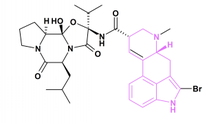Pleuropulmonary Disease and Bromocriptine Therapy The development of pleuropulmonary disease as a result of treatment with bromocriptine has been reported in a small percentage of patients with Parkinson's disease, although some authorities do not believe there is a casual relationship. McElvaney and colleagues describe eight male patients with Parkinson's disease who developed pleuropulmonary disease during treatment with bromocriptine or its related compound, mesulergine. All of the patients were over 55 years of age and were chronic cigarette smokers. No other cause was found for the pleuropulmonary changes.
The pleuropulmonary changes included pleural effusions, pleural thickening and parenchymal disease. All of the patients presented with respiratory symptoms. The duration of treatment prior to the development of symptoms ranged from nine months to four years. The dosage of bromocriptine varied from 22.5 to 50.0 mg daily and the dosage of mesulergine was 6 mg daily.
In six of the patients, the therapy was discontinued, which was followed by clinical, physiologic and radiologic improvement. In two of the patients, bromocriptine was continued for one to two years, and in one of these patients, further physiologic and radiologic progression of the pleuropulmonary changes occurred.
These findings suggest a casual relationship between bromocriptine therapy and pleuropulmonary disease. The mechanism by which bromocriptine induces pleuropulmonary disease remains unknown, but it is possibly an idiosyncratic or hypersensitivity reaction. The authors recommend that chest radiographs and pulmonary function tests be obtained before initiating treatment with bromocriptine. Follow-up studies should be performed if the patient develops respiratory symptoms. Early withdrawal of bromocriptine is necessary if pleuropulmonary disease develops. (Archives of Internal Medicine, October 1988, vol. 148, p. 2231.)
COPYRIGHT 1989 American Academy of Family Physicians
COPYRIGHT 2004 Gale Group



